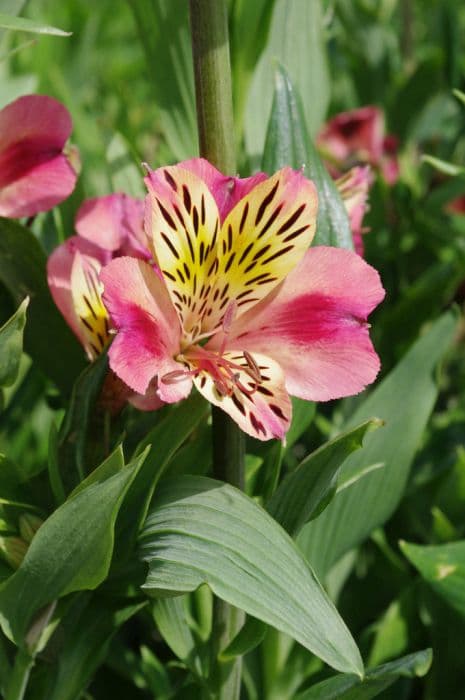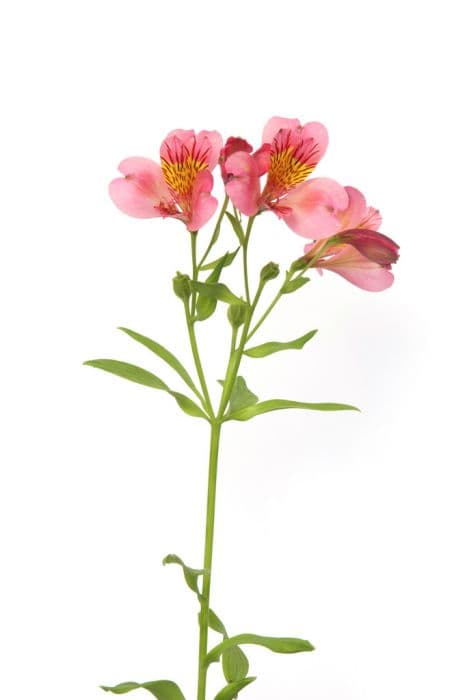Peruvian Lily Alstroemeria 'Amarillo'

ABOUT
The Alstroemeria 'Amarillo', also known as the Peruvian Lily or Lily of the Incas Amarillo, is a vibrant and ornate flowering plant known for its showy blooms and attractive foliage. The Peruvian Lily Amarillo boasts a striking display of flowers, each blossom featuring a unique mix of golden yellow petals often adorned with delicate streaks or flecks of brown or dark chocolate, giving them a particularly exotic look. These conspicuous markings, almost like freckles, are a hallmark of the Peruvian Lily, creating a stunning contrast that enhances the visual appeal of each flower. The individual blooms are trumpet-shaped, typically consisting of six petals that flare outwards, creating a star-like pattern when viewed from above. These petals are complemented by a set of contrasting stamens in the center of the flower, which often possess anthers of a vividly contrasting color, adding depth and dimension to the bloom's overall appearance. The foliage of the Peruvian Lily Amarillo is equally attractive. Leaves are usually a deep, rich green, presenting in a lance-shaped or elongated oval formation. They often grow in a twisted manner, spiraling outwards from the stem, which adds a lush, dynamic quality to the plant's appearance. Their arrangement on the stem is dense, making the plant look full and robust. Certainly, the Peruvian Lily Amarillo adds a touch of brightness and tropical flair to any setting, with its sunny yellow flowers providing a perpetual sense of warmth and cheerfulness. The overall presentation of the plant is one of elegance and vivid color, capable of captivating onlookers with its stunning blooms and spirited character.
About this plant
 Names
NamesFamily
Alstroemeriaceae
Synonyms
Peruvian Lily, Lily of the Incas, Parrot Lily
Common names
Alstroemeria 'Amarillo'
 Toxicity
ToxicityTo humans
The Peruvian Lily, as Alstroemeria 'Amarillo' is more commonly known, is not considered highly toxic to humans. However, it can cause mild irritation if ingested, or if the sap comes into contact with skin. If eaten, the plant can potentially cause nausea, vomiting, or diarrhea. It is always advisable to prevent the ingestion of any part of the plant, especially by children, who may be more sensitive to its effects.
To pets
The Peruvian Lily is also mildly toxic to pets, such as cats and dogs. If a pet ingests part of the plant, it could experience gastrointestinal upset, including symptoms like vomiting or diarrhea. It is important for pet owners to discourage their animals from chewing on the plant and to seek veterinary care if they suspect their pet has ingested any part of it.
 Characteristics
CharacteristicsLife cycle
Perennials
Foliage type
Deciduous
Color of leaves
Green
Flower color
Yellow
Height
2-3 feet (60-90 cm)
Spread
1-2 feet (30-60 cm)
Plant type
Herb
Hardiness zones
7
Native area
South America
Benefits
 General Benefits
General Benefits- Long-lasting blooms: Alstroemeria 'Amarillo' is known for its long flowering season, providing vibrant colors in the garden for an extended period.
- Attractiveness to Pollinators: This plant attracts bees and butterflies, which are beneficial for pollination in the garden.
- Drought Tolerance: Once established, it has a degree of drought tolerance, making it suitable for gardens in drier climates or for water-wise landscaping.
- Cut flower use: The blossoms of the Peruvian Lily make excellent cut flowers with a vase life of up to two weeks, perfect for home decoration or floral arrangements.
- Low maintenance: It requires minimal care beyond the initial planting and periodic watering, which makes it an easy choice for both novice and experienced gardeners.
- Versatility in landscaping: It can be used in mixed borders, as a clumping feature plant, or in containers, offering flexibility in garden design.
- Wide range of colors: Alstroemeria 'Amarillo' offers a variety of colors that can blend well with many other plants and garden themes.
- Hardy nature: This cultivar has a degree of hardiness, allowing it to survive and thrive in a variety of climate zones.
 Medical Properties
Medical PropertiesThis plant is not used for medical purposes.
 Air-purifying Qualities
Air-purifying QualitiesThis plant is not specifically known for air purifying qualities.
 Other Uses
Other Uses- Peruvian Lily petals can be used in culinary presentations as a garnish to add a splash of color to both sweet and savory dishes.
- The sturdy stems of the Peruvian Lily can be utilized in lightweight craft projects, such as making homemade paper or flower wreaths.
- Dried Alstroemeria flowers can be used for scrapbooking and card making, adding a floral touch to creative paper crafts.
- When used in photography, Peruvian Lily can serve as a natural prop for macro photography exercises, emphasizing texture and color.
- The blooms can also be pressed and used to create botanical prints for artwork or fabric designs, displaying their intricate patterns.
- Alstroemeria 'Amarillo' can be used in educational settings to demonstrate plant biology, such as pollination and flower structure.
- The Peruvian Lily's ability to bloom for a long time makes it suitable for time-lapse photography, documenting the blooming process.
- As a natural dye, the pigments of the Peruvian Lily petals can be used to color fabrics or even homemade soaps.
- During festive seasons, Alstroemeria flowers can be strung together to create vibrant, natural garlands for decoration.
- Peruvian Lily's seed pods can be dried and used in sound-making crafts, such as creating mini maracas for children's music activities.
Interesting Facts
 Feng Shui
Feng ShuiThe Alstroemeria, commonly known as the Peruvian Lily, is not used in Feng Shui practice.
 Zodiac Sign Compitability
Zodiac Sign CompitabilityThe Peruvian Lily is not used in astrology practice.
 Plant Symbolism
Plant Symbolism- Wealth - The Alstroemeria, commonly known as the Peruvian Lily or Lily of the Incas, is often associated with wealth due to its lush, vibrant blooms and long-lasting nature, signifying an abundance of resources.
- Prosperity - Its full, rounded flowers are seen as a sign of prosperity, symbolizing success and a flourishing life.
- Fortune - Traditionally, Peruvian Lilies are considered to bring good fortune, making them a popular gift to wish someone luck or to celebrate new beginnings.
- Devotion - The intricate markings and patterns on the flowers' petals are thought to symbolize the intricate bonds of devotion between friends, family, and romantic partners.
- Achievement - The Peruvian Lily often represents personal growth and achievement, celebrating milestones and personal success.
- Friendship - Given as a gift, these flowers often represent the strong and lasting bonds of friendship, due to the plant's resilience and long lifespan.
 Water
WaterThe Peruvian Lily should be watered regularly to maintain moist soil, especially during the growing season in spring and summer. Aim for watering once every week, adjusting for rainfall, with about 1-2 gallons each time depending on the plant size and environmental conditions. Over winter, reduce watering frequency as the plant's growth slows down. Ensure the soil is well-draining to prevent waterlogging, which can lead to root rot.
 Light
LightPeruvian Lilies thrive in bright, indirect light. They perform best when placed in a location that receives some morning sunlight and partial shade in the afternoon to protect them from the intense midday sun. A spot near an east-facing or west-facing window would be ideal for indoor plants, while outdoor plants should be placed in a garden area with dappled sunlight or partial shade.
 Temperature
TemperaturePeruvian Lilies prefer temperatures ranging between 65 and 75 degrees Fahrenheit during the day and no lower than 50 degrees Fahrenheit at night. They can survive in temperatures as low as 25 degrees Fahrenheit, but flowering may be inhibited if the temperatures drop below this threshold. Avoid exposing the plant to extreme temperature fluctuations as they can stress the plant and affect its growth.
 Pruning
PruningPruning Peruvian Lilies is necessary to remove spent flowers and encourage further blooming, as well as to maintain a manageable shape and size. Deadheading regularly during the flowering season promotes continuous blooms. Cut back the entire plant to about 6 inches height once flowering finishes typically in late fall, readying the plant for the next season of growth.
 Cleaning
CleaningAs needed
 Soil
SoilPeruvian lily (Alstroemeria 'Amarillo') thrives best in fertile, well-draining soil with a pH between 6.5 and 7.0. A soil mix that includes equal parts peat, pine bark, and either perlite or coarse sand is ideal, ensuring adequate drainage and aeration. Regular addition of organic matter will enrich the soil and promote healthy growth.
 Repotting
RepottingPeruvian lilies should generally be repotted every two to three years to refresh the soil. However, since they don't like their roots disturbed, repot only when necessary, such as when the plant has outgrown its current container or the soil has significantly degraded.
 Humidity & Misting
Humidity & MistingPeruvian lilies prefer moderate humidity levels. While they can tolerate some fluctuation, maintaining indoor humidity between 40% to 60% is beneficial for the Alstroemeria 'Amarillo'. Avoid placing the plant in overly dry conditions as it may impede growth.
 Suitable locations
Suitable locationsIndoor
Ensure bright, indirect light and keep the soil moist.
Outdoor
Plant in partial sun, shelter from strong winds, well-drained soil.
Hardiness zone
7-10 USDA
 Life cycle
Life cycleThe life cycle of the Alstroemeria 'Amarillo', commonly known as the Peruvian Lily, begins with seed germination, where under the right conditions of warmth and moisture, the seed sprouts and a primary root establishes. The seedling develops into a vegetative state where leaves, stems, and roots grow until it reaches maturity. Once mature, the plant produces vibrant yellow flowers that are distinctive for their streaks and spots, which typically bloom in late spring to early summer. After pollination, which can be facilitated by insects, the plant forms seed pods that eventually dry and release seeds. The Peruvian Lily is a perennial, so after flowering it enters a dormancy phase in colder climates or reduces growth in milder climates, to survive adverse conditions. With the return of favorable conditions, the plant resumes growth from its rhizomes, continuing its cycle for several years.
 Propogation
PropogationPropogation time
Spring-Early Summer
The most popular method of propagating Alstroemeria 'Amarillo', more commonly known as Peruvian Lily, is by division. The ideal time to propagate this plant is in the early spring or late fall when the plant is not in active growth. To propagate Peruvian Lily, carefully lift the clump from the ground and use a sharp knife to divide the rhizomes, ensuring that each division has at least one eye or growth point. These divisions can then be replanted immediately at the same depth they were growing previously, spaced about 12 to 18 inches apart (30 to 45 cm). Water the new plantings well to help establish a strong root system. It is important to handle the brittle rhizomes gently to avoid damage, as this can affect the plant's ability to grow.



![Peruvian lily [H.R.H. Princess Alice]](/_next/image?url=https%3A%2F%2Fplants-admin.emdemapps.com%2Fimages%2Fplants%2F%2Fimages%2F604b55e81c8b0.png&w=640&q=75)
![Peruvian lily [Indian summer]](/_next/image?url=https%3A%2F%2Fplants-admin.emdemapps.com%2Fimages%2Fplants%2F%2Fimages%2F604b616bc746b.png&w=640&q=75)
![Peruvian lily [Inticancha Creamy Dark Pink]](/_next/image?url=https%3A%2F%2Fplants-admin.emdemapps.com%2Fimages%2Fplants%2F%2Fimages%2F604b5e98bea7c.png&w=640&q=75)
![Peruvian lily [Inticancha Dark Purple]](/_next/image?url=https%3A%2F%2Fplants-admin.emdemapps.com%2Fimages%2Fplants%2F%2Fimages%2F604b5381bb78f.png&w=640&q=75)
![Peruvian lily [Inticancha Imala]](/_next/image?url=https%3A%2F%2Fplants-admin.emdemapps.com%2Fimages%2Fplants%2F%2Fimages%2F604b619b522ba.png&w=640&q=75)
![Peruvian lily [Inticancha Red]](/_next/image?url=https%3A%2F%2Fplants-admin.emdemapps.com%2Fimages%2Fplants%2F%2Fimages%2F604b5aebac273.png&w=640&q=75)
![Peruvian lily [Inticancha Sunday]](/_next/image?url=https%3A%2F%2Fplants-admin.emdemapps.com%2Fimages%2Fplants%2F%2Fimages%2F604b646146dd9.png&w=640&q=75)